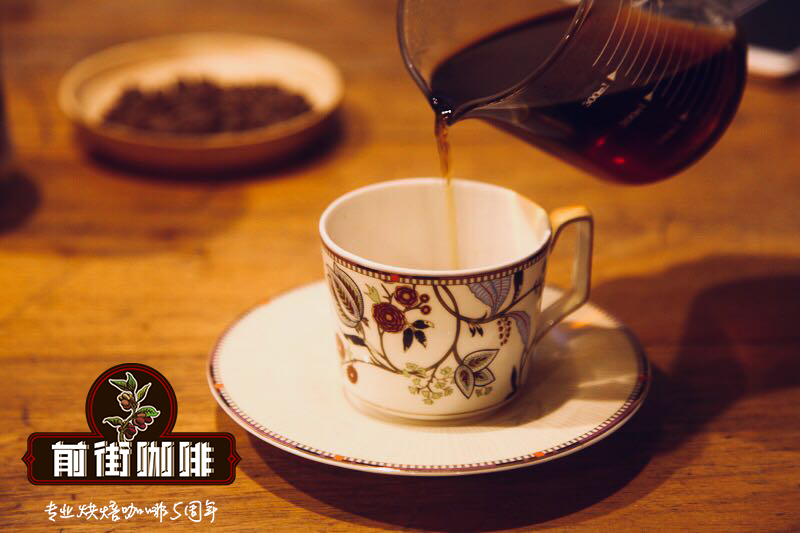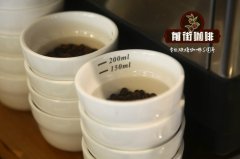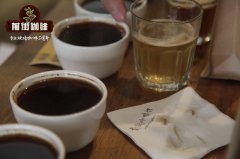Bourbon Coffee Where Bourbon Coffee is Produced History Stories and Variants Coffee Introduction

Professional coffee knowledge exchange More coffee bean information Please pay attention to coffee workshop (Weixin Official Accounts cafe_style)
Bourbon
Tell me briefly what bourbon coffee is. Bourbon coffee was originally grown on the island of Reunion, which was also known as le Bourbon until 1789. Bourbon, a mutant of Typica, is one of the oldest surviving coffee varieties, with green fruits that appear bright red when ripe.
Red Bourbon After the general coffee tree blossoms, the color change of the coffee fruit is from: green> turn slightly yellow> turn slightly orange> turn mature red> turn ripe dark red, so some people call it "red bourbon species", in fact, red bourbon, that is, we generally call Bourbon species. Bourbon grown at high altitudes usually has a better aroma, a brighter acidity, and even a taste similar to red wine.
Bourbon is a coffee tree species belonging to a branch of Arabica species, generally bearing red fruit, called red bourbon, in addition to yellow bourbon, orange bourbon, yellow bourbon relatively low yield, but better quality.
The route of transmission of Bourbon species
Due to the low yield and susceptibility to disease of the tipica species introduced to Brazil in 1727, the bourbon species was introduced to Brazil around 1860 via Campinas in the south and rapidly spread north to other parts of South and Central America. In Latin America today, Bourbon is still cultivated in El Salvador, Guatemala, Costa Rica, Peru, etc., although most of the Bourbon species have been largely replaced by varieties (especially Caturra, Catuai, and Mundo Novo).
In Africa, French missionaries known as Spiritans (from the congregation of the Holy Spirit) played an important role in the spread of bourbon. The first church was founded in Reunion in 1841 and a branch in Zanzibar in 1859; from Zanzibar, branches were founded in Bagamoyo (Tanzania coast, then Tanganyika) and St Augustine (Kikuyu, Kenya) in 1862 and a branch in Bura (Taita Hills, Kenya) in 1893. The establishment of each chapter is accompanied by the planting of coffee seeds brought from Reunion.
Bura's seedlings were taken to another French church in Santa Cruz (near Nairobi) in 1899, introduced to Kilimanjaro in Tanzania in 1900, and distributed to local residents willing to grow coffee. The Kent species was introduced in 1920. So far, coffee in Tanzania has been dominated by bourbon and Kent.
- French dependency Bourbon Island
-1860 Bourbon to New Caledonia Yemen
--1732 Round Bourbon to St. Helena, British dependency.
1860 Round Bourbon to Brazil.
- -1900 Round Bourbon to Rwanda, Kenya, Tanzania
- Pointy Bourbon to Colombia after 2000.
Bourbon variety
In the process of reproduction, many new varieties have been produced due to various factors, such as natural mutation, intraspecific mating, artificial breeding, etc., such as Caturra, Catuai, Pacas, Yellow Bourbon, Pointy Bourbon, SL28, SL34, and a long list of others.
[Gene Mutant-Bourbon Variant]
Bourbon Coffee Yellow Bourbon
The yellow bourbon variety is a cross between bourbon and other varieties. Because of its low yield and poor weather resistance, it is not widely cultivated. However, when planted at high altitudes, it will have excellent flavor performance, which is more common in recent years. Yellow Bourbon, yellow when ripe, originally found in Brazil, now grown mainly in Brazil, It is thought that it may have been mutated by crossing the red-fruited Bourbon species with a yellow-fruited variety of iron-pica called Amerelo de Botocatu.
Once tried Queen Manor yellow bourbon, in the deep roast taste, clean and balanced walnut taste, creamy smooth texture and sweet orange sweetness, full of mocha chocolate lingering in the mouth
Palate characteristics: sweet soft fruit sweet, obvious nutty flavor, balanced soft acidity, bitter slightly clean, rich chocolate aroma and nutty flavor, bright and refreshing taste.
Bourbon coffee powder Bourbon
Pink bourbon, as its name suggests, is the romantic pink color of coffee cherries when ripe. It belongs to a very rare new variety. It is bred by crossing red bourbon and yellow bourbon. Bourbon powder is rare because it is difficult to maintain its beautiful pink color, sometimes harvesting orange bourbon, because the color of the coffee fruit is ultimately determined by recessive genes in the pollen grain. Among the pollen grains we selected for hybridization, there were both yellow and red genes that tended to yellow bourbon, and these were recessive genes that easily interfered with each other.
At present, pink bourbon can be seen in Colombia and Guatemala. Take this batch of powder bourbon coffee as an example. About 1800 coffee trees produce about 1.8kg of fresh fruit per tree in one season. After peeling meat treatment, about 0.36kg of coffee beans are obtained. In a normal season, the crop yields less than 650kg.
Taste characteristics: sweet orange, sugar cane sweet, pleasant juice, small tomato
Bourbon coffee tip bourbon
Bourbon Pointu: Discovered in Bourbon Island in 1810, the bean body has changed from round to pointed, with only half the caffeine content; but the quantity is small and weak, and it is extremely precious (mostly cultivated in the laboratory).
Bourbon Pointu has two other names, Laurina and Leroy, but neither is as famous as Bourbon Pointu. It is called pointed bourbon because the bean is narrow and pointed at both ends, while the original bourbon (some call it round bourbon) is shorter and slightly elliptical in outline.
Because of its good flavor and low caffeine content (which does not interfere with sleep), sharp bourbon has been loved by the world since the 18th century, and many celebrities, such as the French King Luc 15 and the novelist Balzac, are fans of it. 18--19 Pointe bourbon was cultivated extensively on Bourbon Island for two centuries in the 19th century, peaking at 4,000 tons a year in 1800, but then a series of disasters, hurricanes, fire ants, leaf rust, etc., reduced the cultivation to a meager 200 kilograms in 1942, and since then it has disappeared without a trace, not even mentioned in official documents. After the 1950s, coffee was no longer grown on Reunion Island, and agriculture on the island completely shifted to other crops such as sugar cane. Coffee was no longer associated with Reunion Island, and sharp bourbon was recognized as "extinct" by the coffee industry.
In view of the fact that this bean disappeared for half a century and did not reappear in Jianghu until 8 years ago, resulting in bourbon tips produced in La Reunion Island, where it originated, selling for more than 500 yuan per 100 grams in the international market, Colombia also began to grow this bean. Moreover, only Camilo Merizalde, the source of many WBC champion beans, dared to take over the transplantation of this bean. Therefore, this coffee bean, which produces only a few tons of coffee beans worldwide every year, is expensive.
Flavor description on file: Bright acidity, blueberry and vanilla aromas, velvety smoothness
Bourbon variety Pakas
Pacas is a natural variant of Bourbon, similar to Cuturrra in Brazil and Villa Sacrhi in Costa Rica. Like other widely cultivated bourbon variants, Pakas is a new variety resulting from a single-gene mutation, which confers on Pakas a crucial trait: the plant can be planted more densely, which ultimately translates into higher unit yields.
Pacas was first discovered in 1949 by the Pacas family in Santa Ana, El Salvador. Fernando Alberto Pacas Figuero discovered a number of different plants on their family estate Finca San Rafael, and he began collecting seeds and breeding them, later developing the Pacas "Pioneer Nursery" of about 3/4 hectares.
Fernando Alberto Pacas Figuero
By 1956 Fernando Alberto Pacas Trujillo, son of Francisco de Sola and Fernando, with the help of Florida professor William Cogwill, had begun to study the variety Pacas, comparing San Ramon's bourbon with a new "unknown" variety, which exhibited completely different characteristics, plant morphology, shorter node spacing and a larger fruiting area. Finally, They named the breed Pacas.
Related recommendations: How to hand brew Brazilian yellow bourbon coffee beans and red bourbon difference introduction
Important Notice :
前街咖啡 FrontStreet Coffee has moved to new addredd:
FrontStreet Coffee Address: 315,Donghua East Road,GuangZhou
Tel:020 38364473
- Prev

An incomparably rich variety of coffee, Bourbon variants Pacamara, Kaddura, Kaduai and Sachimo
Professional coffee knowledge exchange more information about coffee beans Please follow the coffee workshop (Wechat official account cafe_style) bourbon is as old as tin pickup. Bourbon: a variety of early (prehistoric coffee) iron pickups that changed from a thin tip to a round shape after being transplanted to Yemen. In 1715, France transplanted round beans from Yemeni mocha to bourbon on the east coast of Africa.
- Next

Bourbon Coffee Basics: Which is Yellow Bourbon Yellow Bourbon Flavor Description
Coffee Workshop (Weixin Official Accounts cafe_style) Bourbon coffee (French: Caf Bourbon) is a coffee produced by Arabica Bourbon coffee trees. Bourbon coffee was originally grown in Réunion, also known as le Bourbon until 1789. It was later occupied by France,
Related
- Beginners will see the "Coffee pull flower" guide!
- What is the difference between ice blog purified milk and ordinary milk coffee?
- Why is the Philippines the largest producer of crops in Liberia?
- For coffee extraction, should the fine powder be retained?
- How does extracted espresso fill pressed powder? How much strength does it take to press the powder?
- How to make jasmine cold extract coffee? Is the jasmine + latte good?
- Will this little toy really make the coffee taste better? How does Lily Drip affect coffee extraction?
- Will the action of slapping the filter cup also affect coffee extraction?
- What's the difference between powder-to-water ratio and powder-to-liquid ratio?
- What is the Ethiopian local species? What does it have to do with Heirloom native species?

